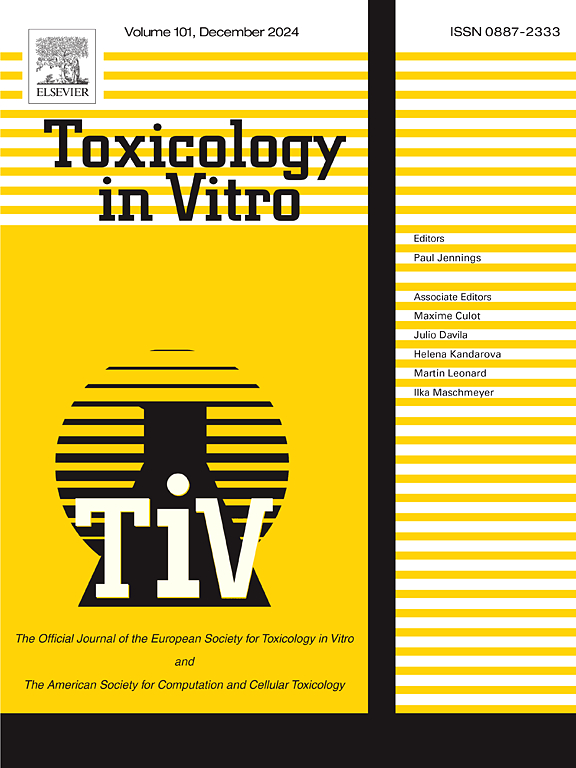Cytotoxicity of ZnO nanoparticles in human melanocyte cells in the presence or absence of UV radiation: A preliminary comparative study with TiO2 nanoparticles
IF 2.6
3区 医学
Q3 TOXICOLOGY
引用次数: 0
Abstract
Zinc oxide nanoparticles (ZnONPs) and titanium dioxide nanoparticles (TiO2NPs), due to their nanometric size and photostability, are increasingly used as ingredients in sunscreens to absorb and scatter UV radiation. However, the current state of knowledge is insufficient to guarantee their safety. Therefore, the objectives of this study were to evaluate the cytotoxicity of ZnONPs and TiO2NPs in the presence and absence of UV radiation in in vitro model of primary human melanocyte cells HEMas. Our research demonstrated that 47 nm TiO2NPs exhibited lower toxicity compared to 25 nm ZnONPs. ZnONPs (5–12.5 ppm) affect various intracellular processes, including cell membrane integrity, proliferative processes, and the induction of morphological changes in cells at the ultrastructural level, particularly in mitochondria. The study highlights intricate mechanisms of cell death induced by ZnONPs, revealing a multifaceted interplay between apoptosis and necrosis. Additionally, we indicate the potential role of intracellular calcium ion influx, notably triggered by ZnONPs, in driving cell toxicity. This influx is linked to endoplasmic reticulum (ER) dysfunction, ultimately leading to cell death, offering valuable insights into the underlying mechanisms of nanoparticle-induced toxicity. Importantly, the co-exposure of both ZnONPs and TiO2NPs with UV radiation (9 J/cm2) enhances the toxic effect on melanocyte cells, indicating an interaction between NPs and UV radiaton and raising potential concerns about their effects on melanocytes and overall skin health.
紫外辐射下ZnO纳米粒子对人黑素细胞的细胞毒性:与TiO2纳米粒子的初步比较研究
氧化锌纳米粒子(ZnONPs)和二氧化钛纳米粒子(TiO2NPs)由于其纳米尺寸和光稳定性,越来越多地被用作防晒霜吸收和散射紫外线的成分。然而,目前的知识状况不足以保证他们的安全。因此,本研究的目的是评估ZnONPs和TiO2NPs在有和没有紫外线辐射的情况下对人原代黑素细胞HEMas的体外模型的细胞毒性。我们的研究表明,与25 nm的ZnONPs相比,47 nm的TiO2NPs具有更低的毒性。ZnONPs (5-12.5 ppm)影响多种细胞内过程,包括细胞膜完整性、增殖过程,以及在超微结构水平上诱导细胞形态变化,特别是在线粒体中。该研究强调了ZnONPs诱导细胞死亡的复杂机制,揭示了细胞凋亡和坏死之间的多方面相互作用。此外,我们指出细胞内钙离子内流的潜在作用,特别是由ZnONPs触发,在驱动细胞毒性。这种内流与内质网(ER)功能障碍有关,最终导致细胞死亡,为纳米颗粒诱导毒性的潜在机制提供了有价值的见解。重要的是,ZnONPs和TiO2NPs与紫外线辐射(9 J/cm2)共同暴露增强了对黑素细胞的毒性作用,表明NPs和紫外线辐射之间存在相互作用,并引发了对其对黑素细胞和整体皮肤健康影响的潜在担忧。
本文章由计算机程序翻译,如有差异,请以英文原文为准。
求助全文
约1分钟内获得全文
求助全文
来源期刊

Toxicology in Vitro
医学-毒理学
CiteScore
6.50
自引率
3.10%
发文量
181
审稿时长
65 days
期刊介绍:
Toxicology in Vitro publishes original research papers and reviews on the application and use of in vitro systems for assessing or predicting the toxic effects of chemicals and elucidating their mechanisms of action. These in vitro techniques include utilizing cell or tissue cultures, isolated cells, tissue slices, subcellular fractions, transgenic cell cultures, and cells from transgenic organisms, as well as in silico modelling. The Journal will focus on investigations that involve the development and validation of new in vitro methods, e.g. for prediction of toxic effects based on traditional and in silico modelling; on the use of methods in high-throughput toxicology and pharmacology; elucidation of mechanisms of toxic action; the application of genomics, transcriptomics and proteomics in toxicology, as well as on comparative studies that characterise the relationship between in vitro and in vivo findings. The Journal strongly encourages the submission of manuscripts that focus on the development of in vitro methods, their practical applications and regulatory use (e.g. in the areas of food components cosmetics, pharmaceuticals, pesticides, and industrial chemicals). Toxicology in Vitro discourages papers that record reporting on toxicological effects from materials, such as plant extracts or herbal medicines, that have not been chemically characterized.
 求助内容:
求助内容: 应助结果提醒方式:
应助结果提醒方式:


